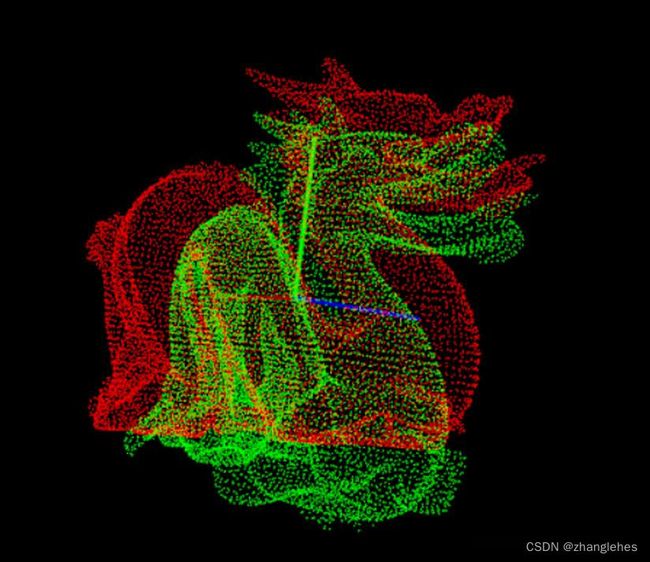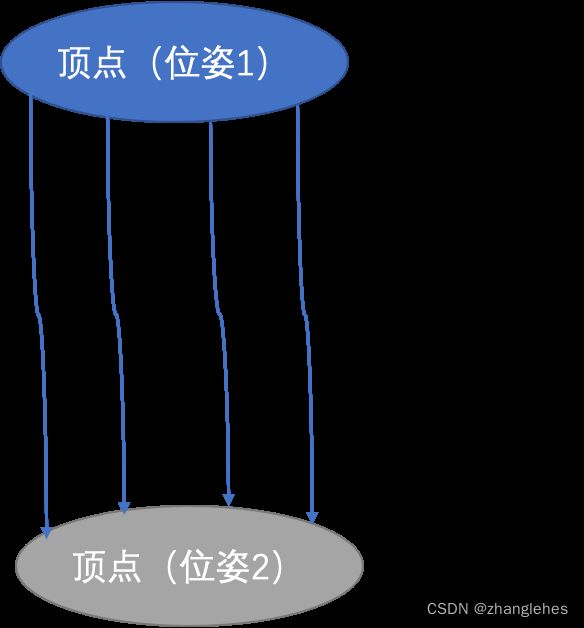g2o--icp代码解析
概要
个人理解Icp是一种location算法。我们先将全局的事物特征化,提取出特征点。在求解过程中,将观察的的图像,同样进行特征化。将全局点与当前特征点进行匹配,就可以求得观察者当前的位姿。
Icp算法通常分为粗匹配和精细匹配两部分。粗匹配是将观察特征点移动到对应全局特征点的附近,而精细匹配这是将一个一个对应的特征点,使用最小二乘优化进行调整。在精细匹配的过程中,特征点对的选取也很重要,icp是一套迭代的算法,每次变换后都需要重新选取特征点对。
在求解一次特征点对匹配过程中,也存在很多中算法。笔者接触过的牛顿法思路比较简单,效果也很好。网上还推荐一种常用的方法svd,也是基于矩阵进行运算。今天介绍的g2o也是一种icp的匹配算法。
所谓的图优化,就是把一个常规的优化问题,以图(Graph)的形式来表述。在图中,以顶点表示优化变量,以边表示观测方程。于是总体优化问题变为n条边加和的形式(边是约束)。
所谓的问题
观测者所在两个位姿,能够看到特征点在自我坐标下的三维位置,并且在两个位姿下的特征点对是明确的,求解两个位姿的相对关系。
建图
源码解析
本文分析的也是g2o自带example中的代码(gicp_demo.cpp)
初始化求解器
SparseOptimizer optimizer;
optimizer.setVerbose(false);
// variable-size block solver
g2o::OptimizationAlgorithmLevenberg* solver =
new g2o::OptimizationAlgorithmLevenberg(std::make_unique(
std::make_unique<
LinearSolverDense>()));
optimizer.setAlgorithm(solver); 初始化1000个特征点
vector true_points;
for (size_t i = 0; i < 1000; ++i) {
true_points.push_back(
Vector3d((g2o::Sampler::uniformRand(0., 1.) - 0.5) * 3,
g2o::Sampler::uniformRand(0., 1.) - 0.5,
g2o::Sampler::uniformRand(0., 1.) + 10));
} 初始化观测者的两个位姿
// set up two poses
int vertex_id = 0;
for (size_t i = 0; i < 2; ++i) {
// set up rotation and translation for this node
Vector3d t(0, 0, i);
Quaterniond q;
q.setIdentity();
Eigen::Isometry3d cam; // camera pose
cam = q;
cam.translation() = t;
// set up node
VertexSE3* vc = new VertexSE3();
vc->setEstimate(cam); // 设定初始位姿
vc->setId(vertex_id); // vertex id
cerr << t.transpose() << " | " << q.coeffs().transpose() << endl;
// set first cam pose fixed
if (i == 0) vc->setFixed(true); // 将第一个点固定
// add to optimizer
optimizer.addVertex(vc); // 将观测者的位姿添加进优化器中
vertex_id++;
} 添加约束
// set up point matches
for (size_t i = 0; i < true_points.size(); ++i) { // 遍历所有特征点
// get two poses
VertexSE3* vp0 =
dynamic_cast(optimizer.vertices().find(0)->second); // 取出观测者第一个位姿
VertexSE3* vp1 =
dynamic_cast(optimizer.vertices().find(1)->second); // 取出观测者第二个位姿
// calculate the relative 3D position of the point
Vector3d pt0, pt1;
pt0 = vp0->estimate().inverse() * true_points[i]; // 计算特征点在第一个位姿坐标系下的位置
pt1 = vp1->estimate().inverse() * true_points[i]; // 计算特征点在第二个位姿坐标系下的位置
// add in noise
pt0 += Vector3d(g2o::Sampler::gaussRand(0., euc_noise), // 添加误差
g2o::Sampler::gaussRand(0., euc_noise),
g2o::Sampler::gaussRand(0., euc_noise));
pt1 += Vector3d(g2o::Sampler::gaussRand(0., euc_noise),
g2o::Sampler::gaussRand(0., euc_noise),
g2o::Sampler::gaussRand(0., euc_noise));
// form edge, with normals in varioius positions
Vector3d nm0, nm1;
nm0 << 0, i, 1;
nm1 << 0, i, 1;
nm0.normalize();
nm1.normalize();
Edge_V_V_GICP* e // new edge with correct cohort for caching
= new Edge_V_V_GICP();
e->setVertex(0, vp0); // first viewpoint 设定边的第一个顶点
e->setVertex(1, vp1); // second viewpoint 设定边的第二个顶点
EdgeGICP meas;
meas.pos0 = pt0; // 设定边中第一个观测点的观测值
meas.pos1 = pt1; // 设定边中第二个观测点的观测值
meas.normal0 = nm0;
meas.normal1 = nm1;
e->setMeasurement(meas); // 设定观测值
// e->inverseMeasurement().pos() = -kp;
meas = e->measurement();
// use this for point-plane
e->information() = meas.prec0(0.01); // 设定权重
optimizer.addEdge(e); // 将该边添加进求解器中
} 求解结果
cout << endl << "Second vertex should be near 0,0,1" << endl;
cout << dynamic_cast(optimizer.vertices().find(0)->second)
->estimate()
.translation()
.transpose()
<< endl;
cout << dynamic_cast(optimizer.vertices().find(1)->second) // 第二个点的位姿是我们最关心的
->estimate()
.translation()
.transpose()
<< endl; 注:
关于边中的normal0和normal1参数的解释 -- https://github.com/RainerKuemmerle/g2o/issues/266

